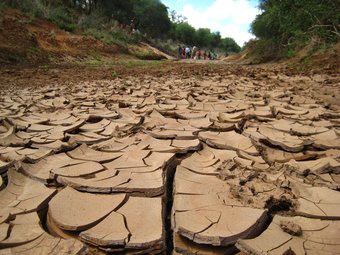Categories
Kenya
Key facts
Hazards covered by anticipation
Conflict and civil unrest | Drought| Floods | Riverine floods
Anticipation partners in country
Kenya Red Cross Society | Start Network | Action Aid | FAO | WFP | Kenya Meteorological Department | National Drought Management Authority | National Disaster Operations Centre | Ministry of Agriculture, Livestock and Fisheries | Ministry of Labour and Social Protection
Inform Risk Index (2022)
Hazard and exposure: 5.3
Vulnerability: 6.0
Lack of coping capacity: 5.9
Total: 5.7 (high)
Rank: 27
Photo: Kenya Red Cross Society / IFRC
Country profile
Kenya is a lower middle-income country, but among the ten largest economies in Africa. Over 50 per cent of gross domestic product comes from the services sector (including tourism), whereas only 25 per cent comes from agriculture. Approximately 40 per cent of people live below the poverty line.
Kenya’s climate varies greatly, from warm, wet and tropical regions along the coastline to temperate mountains in the centre, and arid and semi-arid savannah. The country is exposed to a diverse range of hazards and other challenges: cyclones, wildfires, thunderstorms, earthquakes, landslides, volcanic eruptions, floods, drought, HIV/AIDS and conflict. Of these, drought and floods pose the greatest risk.
Large areas of Kenya are prone to drought, which affects approximately 5 million people in the country each year and contributes to crop and animal losses - and subsequently food insecurity, especially among smallholder farmers and pastoralists in Central Province and around Nairobi. Major droughts occur on average once per decade in the Horn of Africa as a whole, and smaller ones more frequently.
Riverine floods are a seasonal occurrence in Kenya, particularly along the Tana River and near Lake Victoria. Urban areas often experience frequent flooding as a result of intense rainfall and poor drainage. Flooding affects between 50,000 and 150,000 people each year in Kenya, leading to significant loss of life and damaging buildings and public infrastructure.
Projects
The Innovative Approaches to Response Preparedness (IARP) project in Ethiopia, Kenya and Uganda is implemented by the National Red Cross Societies of the three countries and supported by the Netherlands Red Cross, the British Red Cross, the 510.global data team and the Red Cross Red Crescent Climate Centre. The project aims to develop anticipatory actions and institutionalized early action protocols (EAPs) for flood and drought hazards in vulnerable areas in Ethiopia, Kenya and Uganda. This is supported by capacity development in areas of data preparedness and cash and voucher assistance. The development of the EAPs is done in close collaboration with national government agencies and UN agencies to ensure the harmonization of triggers (alert thresholds), early warning messages and anticipatory actions.
In July 2017, the Start Network provided funds to Action Aid to reduce election-based conflict and violence (alert 175). A consortium of organizations in the country offered peacekeeping training and conducted media campaigns to reduce the potential for violence.
Development of forecast-based action mechanisms addressing drought-induced food insecurity in Kenya
In 2020, Welthungerhilfe launched a project to develop a forecast-based action mechanism supporting food security for drought events in Kenya. The project is developing a model for drought triggers, which will activate Early Action Protocols (EAPs) to reduce the risks of food insecurity among vulnerable communities, prevent negative coping strategies, and reduce loss and damages among drought-affected households.
Scaling up anticipatory actions for food security in Africa
In 2021, WFP began a project to strengthen national capacities for anticipatory action through establishing systems for forecast-based financing for drought.
FAO is working to support early action for drought and COVID-19 in Kenya.
The Kenya Red Cross is currently working with national stakeholders to develop an EAP for floods.
Further information
- Kenya: anticipatory action for EVD - update (July 2023)
- EAP for Riverine Floods - activation, November 2023
- Early Action Protocol Annual Report: Kenya - Riverine Floods
- Early Action Protocol Summary: Kenya - Riverine Flood
- Anticipatory Actions for Ebola Outbreak: Kenya - Operational Update
- Early Action Protocol Summary: Kenya - Drought
- Anticipatory Actions towards General Elections in Kenya: DREF Report
- Early Warning Communication for Enhanced Anticipatory Disaster Risk: The Status of Flood Early Warning Communication in Lower Tana and Athi Basins (June 2021)
- Forecasting the Vegetation Condition Index (VCI) for Anticipatory Drought Management (by University of Sussex)
- Understanding the status and need for anticipatory early action in lower Tana and lower Athi River Basins, Kenya
- How can we mainstream anticipatory action in disaster risk-management systems?




